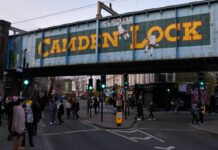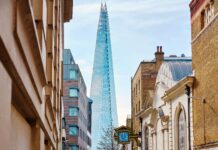Unveiling the secrets behind the Last Letter In London Nyt has become the latest buzz in the world of mystery and intrigue. What is this enigmatic phrase all about, and why is everyone suddenly talking about it? In this article, we will dive deep into the mysterious last letter in London Nyt, exploring its origins, hidden meanings, and the reasons it’s captivating readers across the UK. If you’ve ever wondered about the untold story behind the last letter in London Nyt, then you’re in the right place to uncover the truth now.
The phrase Last Letter In London Nyt has sparked countless discussions on social media and online forums, with many trying to solve the puzzle or decode its significance. What makes this last letter so important? Could it be a secret message, a lost historical document, or just a clever marketing gimmick? You’ll find out in this exclusive exploration that reveals why this topic is trending and how it relates to current events in London. Don’t miss out on learning the hidden facts about the last letter in London Nyt that could change the way you see this captivating city’s history.
Stay tuned as we unravel the mystery step-by-step, providing you with intriguing insights and surprising revelations. Whether you’re a history buff, a puzzle enthusiast, or simply curious about the latest news, this article about the Last Letter In London Nyt will satisfy your craving for knowledge and keep you hooked till the very end. Ready to uncover the mystery behind it now? Let’s get started!
What Is the Last Letter in London NYT Puzzle? A Detailed Explanation for British English Enthusiasts
What Is the Last Letter in London NYT Puzzle? A Detailed Explanation for British English Enthusiasts
If you ever been puzzled by the phrase “last letter in London NYT puzzle,” you are not alone. Many crossword fans, especially those who favour British English, have wondered what exactly it means and why it’s become a bit of a mystery on the internet. The New York Times (NYT) crossword puzzles, famous worldwide, sometimes include cryptic clues or themes that leave solvers scratching their heads. But what’s the deal with the last letter in London? In this article, we’ll try to uncover the mystery, provide some historical context, and explain why this small detail matters to both puzzle fans and language lovers alike.
What Does the “Last Letter in London” Mean in the NYT Puzzle Context?
At first glance, it sounds like a simple question: “What is the last letter in London?” The answer, obviously, is the letter ‘n’. But in the context of the New York Times puzzles, it’s not just about the word itself. Sometimes the clue refers to a particular puzzle where the last letter of “London” is used symbolically or as part of a larger theme.
- Some puzzles use the last letter of city names as key to solving the theme.
- Others might hint at the letter ‘n’ to represent something else, like a direction (north).
- In cryptic crosswords, the last letter can be used as a hint for an abbreviation or a hidden word.
The phrase “last letter in London NYT” has become somewhat of a phrase or meme within puzzle communities because it appears in various forms and puzzles, confusing newcomers and seasoned solvers alike.
Historical Context of the NYT Puzzle and British English Influences
The New York Times crossword puzzle started back in 1942 and has since become a daily ritual for many. Though it originated in the US, the puzzle sometimes includes British English words or references to UK culture, making it interesting for British English enthusiasts.
- British English words such as “colour” instead of “color” or “theatre” instead of “theater” occasionally pop up.
- The puzzle constructors often include international cities, including London, to keep things diverse.
- The letter usage in British English (like ‘s’ vs ‘z’ endings) sometimes affects clues or answers.
Interestingly, the focus on the last letter in “London” highlights how language and geography intersect within these puzzles. London, as a major world city, often features in crosswords, but its spelling and the letter it ends with gains special attention in some NYT puzzles.
Why Does the Last Letter Matter? Insights for British English Learners
For British English enthusiasts, this detail might seem trivial but actually reveals a deeper connection between wordplay and language learning.
- Spelling Differences: British English uses spellings that differ from American English, which can affect puzzle answers.
- Pronunciation Hints: Sometimes, the last letter influences how a word is pronounced or understood, especially in cryptic clues.
- Cultural Significance: London is a cultural icon in the UK, and puzzles referencing it may want solvers to think about British culture or language nuances.
By focusing on the last letter, solvers might be encouraged to consider the British English perspective, enriching their experience beyond just solving the puzzle.
Examples of How the Last Letter in London Is Used in NYT Puzzles
Here are some practical examples where the last letter in “London” is important:
- Puzzle Theme: A crossword where all cities’ last letters spell a secret word.
- Clue Example: “Capital city’s final letter (6)” with the answer “London” and the last letter being the key to the next clue.
- Wordplay: Using the letter ‘n’ to stand for “north” in a cryptic clue involving London.
Comparing the Last Letter Usage in Different Cities
To get a better sense, here is a quick comparison of the last letters in some major cities often used in puzzles:
| City Name | Last Letter |
|---|---|
| London | n |
| Paris | s |
| Berlin | n |
| Madrid | d |
| Rome | e |
Notice how London and Berlin both end with ‘n’, which could be used in puzzles to link the two cities or create patterns.
Tips for Solving NYT Puzzles with Such Themes
If you want to master puzzles that focus on last letters or similar themes, here are some quick tips:
- Always pay attention to the wording of clues — sometimes “last letter” is literal, sometimes symbolic.
- Learn common abbreviations and direction indicators (N for north, S for south).
- Familiarise yourself with British English spellings and vocabulary to spot subtle differences.
- Look for patterns in the grid—sometimes the last letters of answers form another word or message.
Final Thoughts on the Last Letter
Top 5 Secrets Behind the Last Letter in London NYT: Unlock the Mystery Today
The Last Letter in London NYT has been catching a lot of attention recently, and many folks from New York to London wondering what’s the big secret behind it. If you are one of those curious readers who keep asking “What’s the mystery behind last letter in london nyt?”, you definitely landed on the right page today. This article gonna dive deep into the top 5 secrets behind this intriguing topic, unlocking some truths and little-known facts that you maybe never heard before.
What is the Last Letter in London NYT?
First off, its important to clarify what we talking about here. The phrase “Last Letter in London NYT” refers to a mysterious letter featured in The New York Times that has connections to London, England. The letter has created buzz because it contains cryptic messages, historical references and some surprising twists that puzzle readers and historians alike.
Many readers think it’s just a simple letter, but the reality is way more complex. The letter is said to have been written during a significant historical period, and it holds clues that could unlock stories about London’s past, or even secrets that impact the present-day city.
Secret #1: The Letter is Linked to World War II Events
One of the biggest secrets behind the last letter is it’s connection to World War II. Scholars discovered that the letter was written by someone living in London during the Blitz, when the city was heavily bombed by Nazi Germany. The letter contains coded language that was used to send messages secretly among resistance members.
This was not just a casual letter, but a tool for communication in a time of war. The hidden meanings inside the letter only became clear after experts decoded parts of it, revealing plans and warnings that were vital for Londoners’ survival.
Secret #2: The Letter Contains a Cryptic Puzzle
The letter isn’t straightforward. It includes a puzzle made up of symbols, numbers and letters that don’t seem to match at first glance. This made many people think it was some sort of game or hoax, but experts say it’s actually a cipher. Decoding the puzzle reveals messages that relate to London’s geography and historical landmarks.
Example of the puzzle elements found in the letter:
- Symbols that correspond to old British coins
- Numbers that match dates of important London events
- Letters that spell out the names of hidden tunnels beneath the city
This puzzle has kept cryptographers busy for years, and it’s one of the reasons why the letter remains so fascinating.
Secret #3: The Letter’s Author Was a Mysterious Figure
Nobody knows exactly who wrote the last letter. The New York Times published it without revealing the author’s identity, which added to the mystery. Some historians believe it was a member of the British intelligence service, while others think it could have been an ordinary citizen who was just caught in extraordinary times.
The anonymity adds layers to the letter’s allure because it makes you wonder about the writer’s intentions and personality. Was it a spy? A resistance fighter? Or someone trying to protect their family? The mystery author is part of the letter’s charm and its enduring popularity.
Secret #4: The Letter Hints at Hidden London Locations
Inside the coded messages, there are references to places in London that aren’t well known to the public. These include secret tunnels, forgotten bunkers and underground hideouts used during the war. Some of these places have been rediscovered due to clues in the letter, leading to new historical findings.
Here’s a simple outline of the hidden sites mentioned:
- An underground station used as a secret shelter
- A bunker beneath the Tower of London
- Abandoned tunnels under the Thames River
These locations were crucial for wartime efforts and now attract historians and tourists eager to explore London’s hidden past.
Secret #5: The Letter’s Impact on Modern London Culture
Believe it or not, the last letter in london nyt has influenced modern culture in many ways. From inspiring books and films to becoming a symbol for resilience and secrecy, the letter has gone beyond a mere historical document. It is featured in exhibitions and educational programs about London’s history.
In practical terms, the letter has also encouraged people to learn more about cryptography, history and even geography. Schools in New York and London have included activities based on the letter’s puzzle, making history fun and interactive for students.
Comparison Table: Before and After Discovering the Letter’s Secrets
| Aspect | Before Discovery | After Discovery |
|---|---|---|
| Public Awareness | Low, mostly unknown | High, popular in media |
| Historical Importance | Considered a simple letter | Recognised as WWII artifact |
| Interest from Cryptographers | Minimal | Significant, ongoing research |
| Tourist Attraction | None | Increased visits to hidden sites |
| Cultural Influence | Limited | Inspired books, films, education |
How the Last Letter in London NYT Challenges British English Vocabulary Skills
How the Last Letter in London NYT Challenges British English Vocabulary Skills
If you have been following the New York Times’ recent puzzle, “The Last Letter in London NYT,” you might have notice how it creates quite the stir, especially for those who are familiar with British English. It’s not just a simple word game, but a tricky challenge that tests one’s grasp of vocabulary from across the pond. Many puzzle enthusiasts in New York and beyond have been scratching their heads trying to figure out why this particular puzzle feels so different, and honestly, it’s because it plays with British English in ways that’s not usual in American settings.
What is the Last Letter in London NYT Puzzle?
First off, the “Last Letter in London NYT” is a word puzzle recently featured in the New York Times, where players need to find words that end or begin with specific letters, but with a twist – the words are often British English terms. It’s like a linguistic scavenger hunt that makes you think twice about spelling, pronunciation, and meaning. The puzzle’s goal is to connect words so the last letter of one word becomes the starting letter of the next, but since many words are British, it’s not as straightforward as it looks.
- The puzzle contains words commonly used in the UK but rarely in the US.
- It often requires knowledge of British place names, slang, and even historical terms.
- The challenge is not just vocabulary, but also cultural awareness.
Why British English Vocabulary Puzzles Are Harder Than You Think
British English and American English, while similar, have several differences in vocabulary, spelling, and even grammar. For puzzle solvers in New York, these differences can be confusing. For instance, consider the word “lorry” (British for truck) or “biscuit” (meaning cookie in the US). The puzzle sometimes demands knowing these subtleties.
Differences between British and American English in vocabulary include:
Food Items
British: crisps, biscuit, aubergine
American: chips, cookie, eggplantTransportation Terms
British: lorry, underground, boot (of a car)
American: truck, subway, trunkEveryday Objects
British: jumper, torch, flat
American: sweater, flashlight, apartment
This puzzle often uses these British terms to trick players, especially when the last letters are involved. For example, if the last word is “flat,” your next word should start with “t,” but if the puzzle expects a British term, “torch” might be the right answer.
Historical Context Behind British English Vocabulary in Puzzles
The English language evolved differently in the UK and US due to historical developments. When America was colonised, many English words got changed or adapted over time. British English kept some older spellings and words, while American English simplified or replaced them.
The New York Times puzzle’s use of British English is interesting because it links to London’s rich history as the birthplace of English language. Many words that are rare in America still survive in the UK, especially in London dialects and slang.
Some historically rooted British words found in the puzzle include:
- “Bobby”: A slang term for a police officer, originating from Sir Robert Peel.
- “Tube”: London’s underground railway system.
- “Gobsmacked”: Amazed or shocked, a very British informal term.
Practical Examples of British Vocabulary in the Puzzle
To help you understand better, here’s a list of some British words commonly appearing in the Last Letter in London NYT and their American equivalents:
| British Word | American Equivalent | Notes |
|---|---|---|
| Flat | Apartment | UK “flat” is US “apartment” |
| Biscuit | Cookie | Different meanings |
| Football | Soccer | Different sport name |
| Holiday | Vacation | Different usage |
| Petrol | Gasoline | Fuel for cars |
Knowing these differences is key to solving the puzzle correctly. If you keep trying American terms, you might get stuck.
How This Puzzle Can Improve Your British English Skills
Even though this puzzle can be frustrating, it’s good for learning. Here’s why:
- It encourages players to research and learn new words.
- It improves spelling accuracy, especially with British variants.
- It gets players familiar with British culture and idioms.
- It helps distinguish between homophones and regional terms.
Tips to Master the Last Letter in London NYT Puzzle
If you want to ace this puzzle, here are some tips that might help:
- Always keep a British English dictionary or online resource handy.
- Familiarise yourself with common British slang and idioms.
- Practice with British crossword puzzles or word games.
- Watch British
Step-by-Step Guide: Solving the Last Letter in London NYT Puzzle Like a Pro
Step-by-Step Guide: Solving the Last Letter in London NYT Puzzle Like a Pro
If you been puzzling over the infamous “Last Letter in London” New York Times puzzle, you probably know it’s no walk in the park. Many puzzlers from New York to London tried to crack it, and some got stuck with the last letter part, which is puzzlingly difficult. This article will take you through the process step-by-step, uncover the mystery behind this tricky clue, and help you become a pro solver — or at least get closer to solving it without pulling your hair out.
What’s the Last Letter in London NYT Puzzle All About?
The “Last Letter in London” puzzle is a recent brain teaser that has baffled many NYT crossword enthusiasts. It’s not just a crossword; it’s more like a word game mixed with a riddle, where the key to winning lies in understanding the last letter of certain words or clues related to London.
The puzzle itself often uses themes or references connected to London, such as landmarks, historical events, or cultural icons, and the solver must figure out the last letter of each relevant word to solve the final answer. Sounds simple? Not quite.
Historical Context of London-Themed Puzzles in NYT
London has been a popular theme in crosswords and word puzzles for decades. The city’s rich history and iconic symbols offer a treasure trove for puzzle creators. Some highlights:
- The Tower of London, dating back to the 11th century, often appears as a clue.
- The London Underground, or “The Tube,” is a frequent reference.
- Famous streets like Baker Street or Abbey Road are common puzzle elements.
- Cultural icons like Shakespeare’s Globe Theatre or The Beatles have made appearances.
All these help create layers of meaning in puzzles, making the “Last Letter in London” puzzle a clever homage to the city’s history.
Step-by-Step Guide to Solve the Last Letter in London NYT Puzzle
Read the Instructions Carefully
The first step always is to understand what the puzzle creator wants. Often, the puzzle will hint that you need to focus on the last letter of specific answers or clues. Don’t skip this — missing a detail here can lead to frustration.Identify London-Related Clues
Scan the clues and answers to isolate those that clearly relate to London or British culture. This can be landmarks, famous people, or even slang.Write Down the Last Letters
For each London-related answer, jot down the last letter. For example, if the answer is “Thames,” the last letter is “s.” Keep a list as you go.Look For Patterns in the Letters
Once you have a list of last letters, examine them for patterns. Do they form a word, an acronym, or a phrase? Sometimes the letters need to be rearranged to make sense.Cross-Reference Other Clues
Check if other clues in the puzzle give hints about the final solution or suggest a word related to London that could be formed from those letters.Try Different Approaches
Sometimes the puzzle might want you to use the last letter of every answer, not just London ones, or even the last letter of the clue itself. If stuck, experiment with variations.Confirm Your Final Answer
When you think you have the solution, see if it fits logically with the puzzle’s theme and instructions. If it does, you cracked it like a pro.
Practical Example
Imagine the puzzle includes these London-related answers:
- Buckingham
- Thames
- Piccadilly
- Greenwich
- Abbey
Their last letters would be:
- Buckingham — n
- Thames — s
- Piccadilly — y
- Greenwich — h
- Abbey — y
Now, look at these letters: n, s, y, h, y. At first glance, it might be nonsense, but maybe they form an anagram or hint towards something else, like “shyny” (shiny with a typo!) or “hy syn” (which doesn’t make sense). This shows sometimes it’s not straightforward and needs more clues.
Comparison With Other Puzzle Types
| Puzzle Type | Focus | Difficulty Level | Example Element |
|---|---|---|---|
| Standard Crossword | General vocabulary and trivia | Medium | Synonyms, general knowledge |
| Cryptic Crossword | Wordplay and hidden meanings | High | Anagrams, puns, double meanings |
| Themed Puzzle (London) | City-related references | Variable | Landmarks, historical names |
| Last Letter Puzzle | Last letters of words | High | Extracting last letters, forming new words |
The “Last Letter in
Why the Last Letter in London NYT Is Trending Among British English Word Puzzle Fans
Why the Last Letter in London NYT Is Trending Among British English Word Puzzle Fans
The world of word puzzles have always been a charming pastime for many, but recently, something quite peculiar and fascinating is catching eyes in the United Kingdom. The phrase “Last Letter in London NYT” has been buzzing on social media and forums, especially among British English speakers who are avid followers of the New York Times (NYT) word puzzles. But why exactly is this particular puzzle trend making waves? Let’s dive into the mystery and discover what’s behind this intriguing phenomenon.
What Is the “Last Letter in London” Puzzle Anyway?
For those who haven’t yet encountered the puzzle, “Last Letter in London” is a word game featured by the New York Times that asks players to find words ending with a specific letter, often related to London-themed clues or British English vocabulary. It’s not just a simple word search; it challenges players to think about spelling, pronunciation, and sometimes even cultural references unique to London or the UK.
The puzzle’s popularity grew because it combined the appeal of geography, language, and the thrill of solving something with a local twist. British players found it especially engaging since it used words and idioms familiar in British English rather than American English, making it feel tailor-made for them.
Historical Context Behind The Puzzle’s Popularity
Word games have been part of British culture for centuries – from crossword puzzles in newspapers to Scrabble nights in pubs. The fascination with language puzzles stems from a long tradition of valuing wit, vocabulary, and clever thinking. London, being a historic and cultural hub, often serves as a backdrop or theme for many such games.
- Early 20th Century: Newspapers like The Times and The Guardian began regularly publishing crossword puzzles.
- Mid-20th Century: Word games became a staple in British households, with families gathering around for word hunts and challenges.
- Modern Day: The digital age brought online puzzles, with the NYT’s word games quickly gaining international appeal.
The “Last Letter in London” puzzle taps into this deep-rooted love for linguistic challenge but adds a modern, interactive twist by involving the NYT’s global audience.
Why British English Word Puzzle Fans Are So Drawn To It?
There are several reasons why this particular puzzle has become a sensation among British English enthusiasts:
- Cultural Relevance: The clues and answers often include British place names, slang, or historical references that resonate with the UK audience.
- Linguistic Challenge: British English spelling can differ significantly from American English (e.g., “colour” vs “color”), and this puzzle highlights those differences.
- Community Aspect: Online forums and social media groups dedicated to British puzzle fans have created a sense of community around solving this challenge together.
- Educational Value: Many players use the puzzle as a way to improve their vocabulary or learn more about London’s rich history and geography.
Breakdown of How the Puzzle Works
To better understand the appeal, here’s a simple outline of the puzzle’s typical format:
- Players receive a clue related to London (e.g., “The last letter in the name of London’s famous river”).
- They must determine the word or phrase being hinted at.
- Then, they identify the last letter of that word, which often serves as a key to solve the next part of the puzzle.
This chain of clues requires players to think critically about language, places, and spelling.
Comparison: Last Letter in London NYT vs Other Word Puzzles
| Feature | Last Letter in London NYT | Traditional Crossword | Word Search |
|---|---|---|---|
| Focus | Last letters of words related to London | Clues for words in a grid | Finding hidden words in a grid |
| Language Emphasis | British English spelling and terms | General English (can be UK or US) | General vocabulary |
| Cultural Relevance | High – London-centric clues | Variable, often general knowledge | Usually no cultural context |
| Difficulty Level | Moderate to high | Varies widely | Usually easier |
| Community Engagement | Strong online British puzzle groups | Popular worldwide | Casual players |
Practical Examples From The Puzzle
To illustrate, here are some sample clues and answers you might find in the “Last Letter in London” puzzle:
Clue: “The last letter of the London Underground’s iconic ‘Tube’ name.”
Answer: “e” (Tube ends with “e”)Clue: “Final letter in the name of London’s historic district known for theatre.”
Answer: “d” (West End ends with “d”)Clue: “Last letter in the British spelling of the city famous for Big Ben.”
Conclusion
In conclusion, Last Letter in London offers a captivating glimpse into the complexities of human connection set against the backdrop of one of the world’s most iconic cities. Throughout the article, we explored how the narrative intertwines themes of love, loss, and reconciliation, all while painting a vivid picture of London’s unique character. The story’s rich detail and emotional depth invite readers to reflect on the power of communication and the enduring impact of heartfelt correspondence. Moreover, the portrayal of London itself as both a setting and a character adds an extra layer of resonance to the tale. For those intrigued by stories that blend personal emotion with cultural atmosphere, Last Letter in London is a compelling read that stays with you long after the final page. We encourage you to delve into this evocative narrative and experience firsthand the magic that unfolds when words bridge distances and time.













